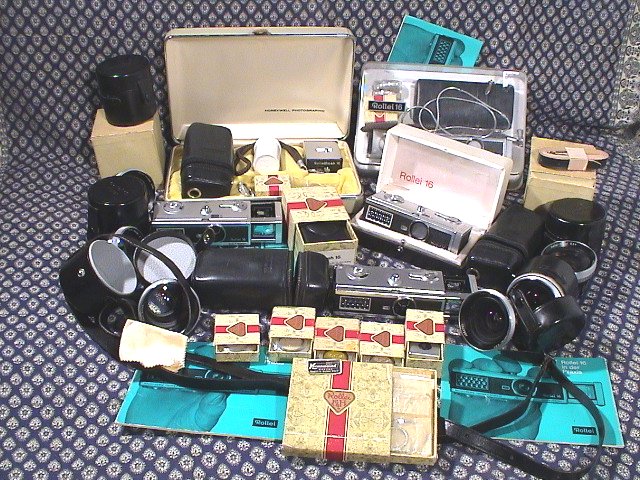
introduction | black (m) | black (Honeywell set 1) | black (Honeywell set 2) | black (m/ft) | cream | accessories

In 1963 Frank & Heidecke of Braunschweig introduced the Rollei 16; possibly the best German 16mm subminiature camera ever made. The Rollei 16 is large, all metal body, typical build quality of Rollei with a Carl Zeiss Tessar f2.8 25mm lens. The body is 110x45x34mm ( 4 3/8 x 1 3/4 x 1 7/16 inches) when closed, extending to 134mm (5 1/4 inches) when the viewfinder is extended. It weights 260 grams (9.125 ounces).
The Rollei 16 and 16s are similar to the Edixa 16, sharing the same RADA Super 16 cassette needing to be rewound back into the cassette when the film is finished, and both having 12x17mm negatives. Unlike the Edixa which uses a take up spool the Rollei needs the bottom perforation to advance the film to the next frame. The optical view finder, with it's white frame parallax correction extends out from the camera body and automatically winds on the film and cocks the shutter. Unlike the Minox A/B and Minolta 16/16II the film is only advanced after the shutter has been released.
Built-in Gossen made selenium meter. Fully automatic exposure control with film speeds from ISO 12 - 200. Shutter speed (B, 1/30 - 1/500) and aperture are set by the meter. This is an EV system camera.
The lens focused to 1.3 feet and additional close-up lenses were available. In addition, wide angle (15mm) and telephoto (43mm) converters were made (called Mutars), making this a very versatile, system camera.
Made in black and chrome, about 28,000 where made.
The Super 16 film uses single perforated film in RADA cassettes giving a 12x17mm image. Double-perforated film means that part of the negative is cut off. The perforations along the bottom of the film are used to advance the film into a take up space. If the back is taken off the film is exposed. With Minolta, Mamiya and Minox only the previous, current and next frame would be lost.
Additional accessories include filters, measuring chain, wrist strap, case, tripod adapter, and flash gun as well as the Mutar wide angle and telephoto lens.
It was rated by William White in his book Subminiature Photography as having one of the best subminiature lenses ever made. Unfortunately problems with film jams as the film is pushed from the cassette into the take up chamber, led to a poor reputation.
Besides the finish of the leather on the cameras three variations are known. The earlier cameras have a focusing scale in metres only with a smaller window and ridge than in the later version that has a dual scale in metric and imperial. There is a red number at 4 metres - the hyperfocal point. Some cameras have the Honeywell logo in a triangle on the end of the camera.
| Years of production | 1963 - 1967 |
| Lens | Carl Zeiss 25mm Tessar f/2.8 with parallax-compensated bright-line view finder and a 45 degree angle of view |
| Aperture | f 2.8, 4, 5.6, 8, 11, 16, 22 |
| Shutter Speeds | B, 1/30 - 1/500, automatic exposure with manual settings for B and flash use |
| Focus | 16 inches (40cm) to infinity |
| Flash sync. | electronic flash and bulbs at 1/30 second |
| Negative Size | 12x17 mm, 18 exposures |
| Finishes | chrome - matt aluminium with inlay in a choice of black, black snake, cream snake, green and red |
| Supplied | |
| Manuals | English, German |
| Dimensions | 4.375 inches (long - viewfinder closed) x 1.125 inches
(high) x 1.75 inches (thick) 11 x 2.9 x 4.3 cm |
| Weight | approx. 9.125 ounces, 260 grams |
| Lens | Carl Zeiss 25mm |
| Aperture | f 2.5 - f 22 |
| Shutter Speeds | B, 1/30 - 1/250 |
| Flash sync. | |
| Negative Size | 12x17 mm |
| Finishes | chrome - matt aluminium with black inlay |
| Supplied | Possibly case. Strap is missing from most cameras for re-sale. |
| Manuals | English, German |
| Dimensions |
| Case | Leather black |
| strap | platted cord with metal clip |
| Measuring chain | snake type chrome |
| Filters | H1 0x, R1 0x, R1.5, R2 0.5x, green, orange, yellow |
| Auxiliary lenses | Mutar 15mm 0.6x wide, 43mm 1.7x telephoto |
| Tripod/Copy Stand | see accessories for Rollei 16s |
| Flash Bulb unit | includes thread for tripod |
| Lens Opening | Without Close-up Lens | With Tele Lens | With Wide Lens |
| F 3.5 | |||
| F 4 | |||
| F 5.6 | |||
| F 8 | |||
| F 11 |